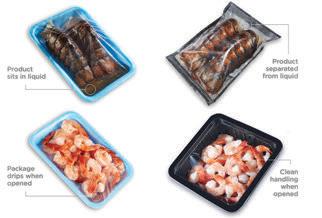
25 minute read
Packaging Technology
AARON HAND | EXECUTIVE EDITOR
Active Packaging Technology Improves Seafood Safety, Shelf Life
The SeaWell Protective Active Packaging System from Aptar Food + Beverage – Food Protection integrates technology that keeps excess liquid from accumulating around the seafood, thereby reducing bacterial growth, preserving quality, and improving consumer perception.
THE SEAFOOD INDUSTRY has long faced a number of challenges at the grocery store—a perceived lack of freshness, excess liquid in the package that can cause contamination issues, and concerns about safe handling. Advances in active packaging are working to combat these problems, thereby extending seafood shelf life, mitigating in-package liquid buildup, and improving hygiene through a more touchless consumer experience.
In a study with Virginia Tech, Aptar Food + Beverage has shown the ability of its SeaWell Protective Packaging System to reduce bacterial growth and preserve seafood quality throughout the supply chain. Launched in mid-2020, the packaging integrates technology that absorbs excess liquids that would otherwise accumulate around the seafood. The absorbent materials trap excess fluids inside pockets or wells integrated into the bottom of the package—also improving consumer perception.
As the world’s most widely traded animal protein on a global basis, seafood in the U.S. is nonetheless consumed at significantly lower rates. Perceived lack of freshness and safety are drivers in this consumption gap, Aptar notes in a scientific paper focused on its SeaWell technology. “Even closer to the coasts, the seafood industry faces longstanding struggles to convince consumers of product freshness and safety,” the paper says, citing a study from Sustainable Fisheries. “With 62 to 65% of U.S.-consumed seafood originating from other countries, even those who live near the ocean may find themselves buying seafood that has traveled thousands of miles to reach their kitchens.”
Your seafood is weeping
Packaging can play a key role not only in maintaining seafood freshness and safety, Aptar argues, but also in improving consumer perception.
Often, seafood is packaged in foam trays with synthetic pads and overwrap. It’s a cost-e ective solution, but it provides little protection from the buildup of bacteria and excessive liquid. Punctures and leaks are common throughout the supply chain, so those packages often need to be rewrapped as well. Premium packaging solutions such as vacuum skin packs still fail to handle the high levels of liquids that seafood produces, Aptar says.
It’s inevitable that seafood will weep—meaning it will lose weight related to moisture emission. “However, an extensive amount of weeping is an indication of food proteins breaking down and an overall product quality degradation,” explains Christa Biggs, manager of business development for Aptar Food + Beverage – Food Protection. “The SeaWell system controls excess liquid
IMAGE COURTESY OF APTAR
The SeaWell technology can be incorporated into absorbent trays and pouches to significantly limit liquid buildup to improve safety and extend freshness and shelf life.
that would otherwise accumulate in the package. This control of excessive liquid buildup decreases the availability of water, which in turn slows the protein breakdown process by decreasing the rates of chemical reactions and microbial growth.”
The SeaWell technology leverages a proprietary three-phase Activ-Polymer platform that can be incorporated into absorbent trays and pouches to significantly limit liquid buildup to improve safety and extend freshness and shelf life.
The trays are thermoformed with cavities into which a generally recognized as safe (GRAS) technology blend is dropped and secured with a heat-sealed piece of nonwoven fabric. This creates a “false floor” in the tray, separating the seafood from any standing liquids. As the seafood thaws, the naturally released liquids fall through the nonwoven fabric into these cavities, reacting with the proprietary GRAS ingredients to form a gel that remains secured in the wells of the tray.
The pouch configuration works with bag packaging. In this case, the absorbent blend is housed in quilted pockets on the back of the bag, hidden by the seafood contained within it. This provides the same liquid separation e ect to protect the seafood from pathogen growth.
Independent validation
A study conducted by Virginia Tech showed that optimizing liquid control slowed the growth of bacteria in the package, thereby slowing product degradation. Comparing the microbial growth and kinetics of spoilage between scallops packaged in a SeaWell-based tray vs. standard packaging, the study found that scallops stored in the control group achieved a bacterial count of 6 log CFU/g (considered the limit for food spoilage) 12-13 days after storage, while scallops stored in Aptar’s system did not reach the same threshold until 15-16 days after storage.
The Virginia Tech study also monitored the total weight changes of scallops during 20 days in storage—another way to measure microbial and chemical spoilage. Conventional packaging showed a weight/ moisture loss of 46% in the scallops while those packaged with the SeaWell technology lost only 30%. The area loss of the scallops was also significantly lower in the SeaWell-based packaging.
Packaged for food safety
Though the Virginia Tech study demonstrated that SeaWell provides an increased shelf life for seafoods, that is not the primary draw, according to Biggs. “For
GREAT PRODUCTS GREAT IDENTITIES
LABELING AND SLEEVING SOLUTIONS
As more and more brands and SKUs enter the market, how do you make your product stand out from the crowd? A great brand identity supported by great graphic designs is one way to create a competitive edge. P.E. Labellers and Axon, product brands of ProMach, o er labeling and sleeving systems that can accommodate a virtually unlimited range of container types, shapes and sizes. From P.E. Labellers' pressure sensitive, cold glue, hot melt and roll-fed labelers to Axon's shrink sleeve and stretch sleeve labeling systems, we o er the broadest range of labeling technologies in the industry. If you have a product that needs a label, a shrink sleeve or a stretch sleeve, give us a call to discuss your application.
PERFORMANCE, PACKAGED
more brand owners and consumers, the most important aspects are providing a superior seafood handling experience and a safer product, more so than simply elongating shelf life,” she explains. “There’s a finite interest in seafood having too extensive a shelf life, since ingrained consumer familiarity with seafood’s comparably brief peak freshness period means that further-out expiration dates may unintentionally arouse suspicion rather than convey higher quality. However, being able to add a few extra days has certainly allowed our customers a supply chain cushion, as well as decreased food waste.”
Though retailers often look at their fresh-counter seafood as a di erentiator of high quality, the consumer has no way of knowing how fresh that seafood actually is. “Most supermarkets and large retail stores have their seafood products shipped to them, often from many miles away,” Biggs notes. “For seafood to travel these distances without spoilage or degradation, it is usually shipped and received frozen. So typically, even the seafood you see in fresh counters needs to go through a secondary thaw process before being displayed.”
The SeaWell system supports this same process, Biggs adds, the di erence being that the product can be thawed inside the packaging, eliminating the need for human handling and minimizing contamination. “The retailer can simply take the product from a frozen environment to a refrigerated one and allow it to thaw in the package before merchandising,” she says.
Aptar advocates the advantages of pre-packaged products not only for consumer comfort and convenience, but also the ability to add owner-controlled label language that can speak directly to the in-home handling process. Pre-packaged formats allow for a production date, recipes, and brand sustainability commitments. In a shelf-life challenged industry, consumers can be educated on the benefits of the active packaging a seafood provider is using.
“This suggested protocol shift has been well received, as many supermarkets have long had a difficult time keeping their fresh counters open, since it is typically a high-cost and high-labor food retail component,” Biggs says. “And now, as e-commerce emerges and evolves through conveniences like in-store pickup and home delivery, a safer way to transport seafood is necessary.”
Aptar Food + Beverage – Food Protection
www.aptarfoodprotection.com

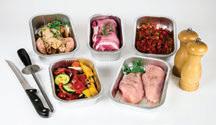
• Aluminum provides an absolute barrier at even a very low thickness with unique properties that provides an excellent source for heating and keeping cold. • Smooth Wall aluminum is suitable for Gas Flushing, MAP, CAP and Vacuum Packaging resulting in extended shelf life. • Smooth Wall aluminum also works well in a Freezer, Microwave, Oven, Broiler, Grill, Turbo-Chef,
Cooktops, Toaster Oven, and is 100% infinitely recyclable.
JOYCE FASSL | EDITOR IN CHIEF
Eye on Sustainability

From packaging reductions and recycling projects to water, compressed air, and other utility savings, food and beverage processors have not taken their eyes o the ball when it comes to protecting the planet.
IN THE ERA OF RISING INFLATION, shifting consumer habits, and post-pandemic operational planning, sustainability remains front and center for food and beverage manufacturers.
Concerns about environmental and social well-being are becoming less abstract and more tangible, according to a recent report from the Hartman Group. The research says consumers are reconsidering what sustainability really means to them, how di erent components of sustainability a ect them, and whom they will hold responsible for addressing these challenges.
In the report, 78% of consumers said they are familiar with the term sustainability, yet only 15% can identify a sustainable company. In addition, 28% of consumers told the Hartman Group they are willing to pay more for products from companies that support their values.
All this business intelligence is, of course, extremely important for food and beverage manufacturing success. Consequently, despite the many challenges faced during the height of the COVID-19 pandemic, processors never shifted their eyes away from environment matters.
Each year, ProFood World recognizes the leading projects undertaken by food and beverage facilities across North America with its Sustainability Excellence in Manufacturing Awards (SEMA). Given for one-time projects as well as ongoing programs, the awards honor companies and individuals that seek to go beyond environmental compliance. In 2020, ProFood World added a new category to the SEMA awards—the Processor/Supplier Partnership Category—to recognize the growth and importance of collaboration between processors and industry suppliers in protecting the planet.
All entries were judged by a team of food industry peers. The winners will be honored at a special session at PACK EXPO Las Vegas on Sept. 27.

Installation of an air-cooled air handling unit in place of a water-cooled unit at B&G Foods’ Cincinnati facility has significantly reduced water usage.
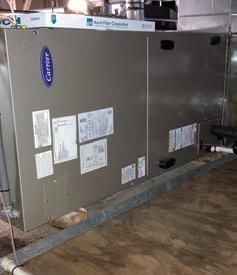
PHOTOS COURTESY OF B&G FOODS
FIRST PLACE PROGRAM CATEGORY
B&G Foods’ Water Reduction Program Empowers Employees to Make a Difference
With a goal to minimize its environmental impact, B&G Foods’ Cincinnati Crisco facility has been on a journey to reduce water usage for the past 10 years. In 2020, the plant implemented several water-reduction projects, including the revision of temperature settings for process operations; installation of an air-cooled air handling unit in place of a water-cooled unit; and implementation of program changes to automate water valve shuto s, according to Plant Engineer Karen Hales. “These changes resulted in a reduction of water usage by 19.5% vs. the prior year, despite an increased production volume of 38%,” she states. The 2020 project’s return on investment was achieved in four months.
Since 2011, the site has reduced water consumption by more than 250 million gal, equaling a greater than 75% reduction. The program benefits not only the company in terms of lower costs, but also the community and future generations by conserving a valuable natural resource. “With a focus on minimizing water use, this program can be integrated into many manufacturing and community programs,” Hales explains. “We have also shared our learnings with many other manufacturing sites.”
Key facets of the program include eliminating once-through water applications, optimizing process temperature settings, automating water shuto s, maintaining water systems, and driving continuous improvement with data analysis.
Hales says the water reduction program has evolved over the past 10 years at the Cincinnati Crisco site. “On this journey, we have incorporated learnings from other manufacturing plants on water reuse, partnered with consultants, and tapped into our employees’ insights and knowledge,” she says.
“Continuous improvement is achieved by data collection, trend analysis, feedback communication, and the continued mindset to challenge the status quo,” Hales states. “Our motto, which we share with all new employees to the site, is ‘Our actions can impact the Earth…Welcome to Team Earth.’”
SECOND PLACE PROGRAM CATEGORY (TIE)
Conagra Brands Succeeds With Compressed Air, Steam, and Vacuum Leak Reduction Project
This award-winning initiative involved Conagra Brands’ Menomonie, Wis., facility purchasing an ultrasonic imager. The imager detects compressed air and steam leaks in the facility and provides a survey for every leak that is detected, including an ultrasonic picture showing exactly where the leak is, the CFM

PHOTO COURTESY OF CONAGRA BRANDS
Conagra Brands’ Menomonie, Wis., team displays the ultrasonic imager that helps it identify air leaks.

rate of the leak, and the associated annual energy savings in kilowatt hours, depending on the local electricity prices. “We developed a program where maintenance will go out and use the imager to find air and steam leaks,” says Maria Peers, senior manufacturing system engineer.
“The area planner creates the work order for the leak to be fixed,” says Peers. “We have a tracker where we document all leaks, including the summary report from our partner vendor with the potential cost savings and kilowatt hours saved, the work notification, work order number, and date of completion. We review the status of the leaks monthly.”
After five months, the Menomonie facility saved 152,829 kWh of electricity, equal to saving about $17,000, by fixing compressed air leaks. The ultrasonic imager allows the plant to identify leaks while equipment is running. The project eliminated more than 95 metric tons of scope 2 greenhouse gas emissions.
“The imager was purchased in March 2020, and we started using it shortly after then,” says Peers. “Prior to purchasing the new imager, we were able to see how the unit worked to make sure it was worth the investment.”
The payback was realized in less than six months. “This tool makes it very easy to identify and understand how large a leak is and the associated electricity cost,” adds Peers.
SECOND PLACE PROGRAM CATEGORY (TIE)
Conagra Brands Facility Pursues Zero Waste Recycling
At Conagra Brands’ Waterloo, Iowa, facility, “stars and bars” are small pieces of plastic created when formed cups are cut and separated. “Our stars and bars have long been a recycling challenge, because a foil lid stock is attached to the plastic,” states Plant Manager Steve Schultz. Recycling the waste has been a challenge for the past several years, forcing the facility to landfill this material, a ecting the site’s landfill diversion e orts.
The Waterloo facility worked with its material supplier, which recently partnered with a recycling center, to invest in equipment to delaminate the foil from the plastic, making both materials more readily recyclable.
“With this new vendor, we are able to divert about 80,000 lb of plastic from the Waterloo, Iowa, landfill per month, which represents over 10% of the site’s total waste,” according to Schultz. “By recycling these materials, we are limiting our impact associated with plastics in landfills.”
There has been a significant labor reduction at the plant since completing this project. “Prior recycling e orts constituted baling the stars and bars, which is a labor-intensive task,” explains Schultz. “The new method requires far less hands-on work, reducing exposure to ergonomic and other types of hazards.”
“We have been reaching out to countless recyclers and, of course, suppliers in hopes of finding a waste stream for the stars and bars material. Through the refuse-to-lose attitude of our Waterloo team that genuinely cares for our environment, we were successful in getting this plastic into a recycle waste stream instead of placing it into our landfill by remaining passionate and persistent.”
PHOTO COURTESY OF CONAGRA BRANDS
Working with a new vendor allows Conagra Brands’ Waterloo, Iowa, facility to ship waste instead of landfilling it.
THIRD PLACE PROGRAM CATEGORY
Conagra Brands Cuts Water Usage for Its Cherry Fresh Pack Product
In 2020, an intern at Conagra Brands’ Fennville, Mich., plant was tasked with reducing water consumption during the fresh cherry packaging season. The Fennville team has implemented several projects developed during the intern’s tenure to reduce the water usage by 2.5 million gal per year.
One project replaced valves to limit water losses, which will save $11,000 in water and wastewater treatment electricity costs. Another allows water from cherry grower trucks to be reused in the plant’s chilled water system, saving another $1,500.
“By reducing our water usage by 2.5 million gal, we are working to limit our impact on the local watershed and biodiversity,” states Kayla Bradford, EHS specialist. The two projects cost less than

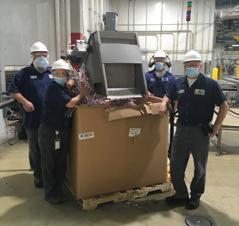

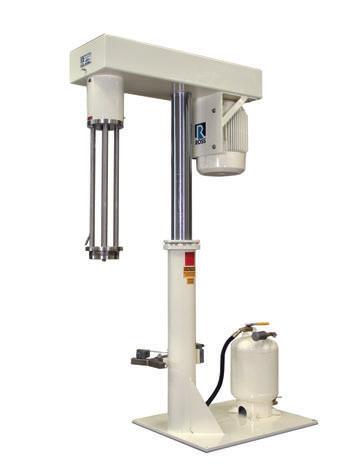
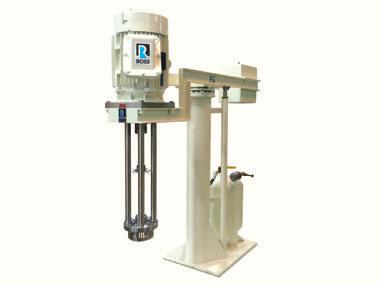
Mix & Batch Solutions
Ross rotor-stator High Shear Mixers work fast to mix, disperse, emulsify and homogenize at speeds up to 4000 ft/min. Batch models o er greater control when mix composition and timing are critical, production quantities are small, or when producing multiple formulations on one process line.
As the leader in rotor-stator technology, Ross has the rotor-stator configuration to tailor a High Shear Mixer to your application. Need larger capacity, high production output? Ross has inline models, too. Need larger capacity, high production output? Ross has inline models, too.
Learn more at highshearmixers.com. Call 1-800-243-ROSS or try our free online Knowledge Base & Product Selector web app at mixers.com/web-app

IMAGE COURTESY OF CONAGRA BRANDS
Programs to limit water losses saved millions of gallons of water for Conagra Brands’ Fennville, Mich., plant. $2,000 in total and will result in $12,500 in savings. In addition, the 2.5-million-gal water reduction project represents 5.2% of the site’s 12-month prior total water use. Project return on investment was realized in less than two months.
FIRST PLACE PROJECT CATEGORY
Smith eld’s Switch From Cardboard to Reusable Plastic Totes Pays Off
Smithfield Foods’ Sioux City, Iowa, facility has made several positive impacts with its landfill reductions and recycling e orts. This winning project’s goal was to reduce cardboard usage at its source and decrease the amount of cardboard either sent to landfill or recycled.
Previously, 4×4×5-ft triple-wall cardboard boxes on pallets, known as combos, were used to hold raw products for further in-plant processing. The more than 11,000 cardboard combos used annually created 100 tons of waste. In addition, cardboard boxes were used to ship processed products to other Smithfield facilities for further processing, creating another 96 tons of waste. “Changing these two processes to utilize reusable, folding, plas-
A switch away from cardboard to reusable plastic totes and baskets not only saves money for Smithfield’s Sioux City plant, it also reduces cardboard sent to landfill. tic combos and baskets greatly reduced cardboard waste,” says Smithfield Environmental Coordinator Ross Weatherford. “With reusable baskets replacing boxes, the waste is further recycled beyond the Sioux City plant.
“The cardboard reduction project also helps the plant’s goal of becoming landfill free and reduces the cardboard recycling transportation costs,” states Weatherford. In addition, it saves more than 3,300 trees per year.
The project was completed in May 2020, and payback was achieved in three-and-a half months. Projected savings over five years are expected to be more than $1 million.
This project was originally started at Smithfield’s facility in Sioux Falls, S.D. Reusable collapsible boxes were used to send product to other plants, and reusable totes were used in-house. After some research and logistical realignment, the project was implemented at the Sioux City plant for similar operations. Any Smithfield plant that ships products to another Smithfield facility can use the reusable combos and baskets rather than cardboard combos and boxes. The use of plastic totes will increase sanitation workload, because they must be cleaned before they are reused, Weatherford notes.
SECOND PLACE PROJECT CATEGORY (TIE)
Smith eld Air Knife Energy Reduction Project Saves Compressed Air Costs
Smithfield Foods’ Kinston, N.C., facility uses air knives on two of its packaging lines to remove moisture before applying code dating, but air was discharged continuously, even if product was not coming down the line.
“Compressed air is our second-largest energy user at the facility,” states Smithfield Environmental Coordinator Charlie Prentice. “As a simple and inexpensive fix, we installed photo eyes and timers on the knives. They are now set to cut o air to the knife if an eye does not detect product within three seconds, reducing the demand on our air system and eliminating an estimated 11,351.04 kWh from our annual plant usage.”
The project was implemented in December 2020 on one packaging conveyor line where a photo-eye sensor with a timer was installed. Another packaging conveyor line had a laser with a power supply and timer installed. “Both lines were completed using parts and materials from our own stockroom,” says Prentice. “Installation was quick and easy and completed in four days.”
When calculating the estimated energy usage of the two air knives before and after installation, the reduction is 6.5%. “This original idea was put in place by our maintenance team that has been challenged





s The simple change of installing photo eyes and timers on its air knives allows Smithfield’s Kinston facility to cut air to the air knife when it is not needed, providing energy savings.
PHOTO COURTESY OF SMITHFIELD FOODS
with energy reduction goals of 5% over the next four years,” adds Prentice.
This very simple project provides excellent savings for the Kinston facility. “Depending on the location and size of product coming down the line, a small bracket might need to be made and possibly welded to your conveyor,” explains Prentice. “But overall, it is a quick and easy installation.”
SECOND PLACE PROJECT CATEGORY (TIE)
Conagra Brands Paper Waste Reduction Project Is on a Roll
Conagra Brands’ Maple Grove, Minn., plant operates four microwave popcorn presses to support its Orville Redenbacher and Act II businesses. These lines utilize speed splicers to make paper splices from roll to roll, which use older technology and have less precise methods for triggering a paper splice. Working with partner vendors and contractors, the plant incorporated a laser measurement to automatically trigger the paper splicer, allowing it to use more of the paper on the end of the roll.
“By utilizing more of the paper on the roll before splicing o , we reduce waste and save money in material savings and recycling costs,” says Keith Huegel, plant engineering manager. “This project saves a fraction of each roll, but over the course of the year that equals approximately 35 tons of waste and 3.3% of the site’s total waste.”
Huegel says the measurement lasers were installed on two presses in January 2020 and have been operating well since. The presses have netted about $20,000 in savings for each line, representing a significant return on investment. The project took less than two months to plan and implement.
The idea for the project emerged when a Conagra Brands plant engineer attended PACK EXPO and discussed ways to improve the plant’s current operation with an exhibitor.
“Any facility that is unwinding a material on a core may be able to benefit from the technology to use as much of the material as possible left on the core,” says Huegel. “It was important for us to get the vendor and contractor involved early to find the best solution. As we get closer to the core, the more critical it is that the vendor has a good starting wind of the material on it. We will be working with them to maximize our material use.”

Meet the 2020 Winners at PACK EXPO Las Vegas
The 2020 Sustainability Excellence in Manufacturing Award winners will present more details on their green projects at a special session during PACK EXPO Las Vegas. Join us on Monday, Sept. 27 at 3:30 p.m. at the Processing Innovation Stage at booth N-24020 in the North Hall of the Las Vegas Convention Center.
Register now at www.packexpolasvegas.com.
ProFood World wants to hear about your current green projects. The submission deadline and eligibility requirements for the 2021 Sustainability Excellence in Manufacturing Awards will be announced this fall at pfwgo.to/sema.
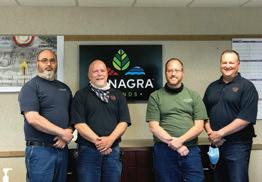
PHOTO COURTESY OF CONAGRA BRANDS
Conagra Brands’ Maple Grove, Minn., team incorporated laser measurements to automatically trigger paper splices, allowing it to use more of the paper on the end of a roll.



THIRD PLACE PROJECT CATEGORY)
Smith eld Packaging Reduction Nets Savings in Ham Production
The Smithfield Foods facility in Kinston, N.C., was on a mission to decrease its cost for and waste of the continuous net used to apply smoke to hams. The netting arrives wrapped in a plastic liner inside a cardboard box.
“We saw an opportunity to increase our piece count per case by increasing the length of the netting per case,” states Smithfield Environmental Coordinator Charlie Prentice. “Adding length was favorable to the supplier, which could decrease its packaging costs, save on shipping, and have more e cient operations.”
In turn, Smithfield benefitted from a lower cost per foot of netting and decreasing the amount of packaging waste to be hauled. The netting was increased from 1,300 ft to 2,050 ft, and the test runs were successful.
Based on the plant’s annual volume for hams, the new netting reduces the number of material cases by 2,541. “This amounts to around 2.54 tons of cardboard and plastic saved,” states Prentice. “The reduced waste helps us come closer to our goal of zero waste to landfill.”
He says implementing a fundamental change such as this shows Smithfield’s commitment to decreasing its carbon footprint and promoting sustainability. The project will also have waste-reducing implications at Smithfield’s Grayson, Ky., facility where the same casing is now in use.
The project was completed in January 2020 at no cost. It took three months for the research and testing.
“We are always looking for package reduction projects,” says Prentice. “Seeing wasted netting and continuous reloading of the machine, it just made sense to look into a more cost-e ective way.”
Prentice advises communicating with suppliers and your purchasing department to see if larger pack sizes are available. “If not, ask if one can be created for your location and others within the company’s network.”

PROCESSOR/SUPPLIER PARTNERSHIP CATEGORY
Liffey Meats and Graphic Packaging International Support Lidl’s Sustainability Goals

A recent partnership of Li ey Meats and Graphic Packaging International will supply 2 million PaperSeal tray units annually to Lidl. The packaging includes a fully lined, cut, and glued PaperSeal tray—a barrier-lined paperboard alternative to traditional plastic vacuum skin packaging (VSP). The new Lidl product, made exclusively for the Irish market, will feature Angus and dry-aged Angus with full farm-to-fork traceability from Li ey Meats.
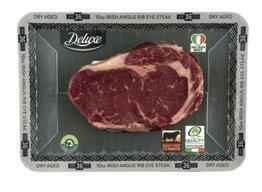

Graphic Packaging International
www.graphicpkg.com

PHOTO COURTESY OF GRAPHIC PACKAGING INTERNATIONAL
Retailed at Lidl Ireland, Li ey Meats uses the PaperSeal tray, a barrier-lined paperboard alternative to plastic vacuum skin packaging.

The PaperSeal tray features 80 to 90% less plastic than traditional trays, supporting Li ey and Lidl’s sustainability goals,” explains Lauren Hutchinson, senior sales manager for PaperSeal at Graphic Packaging International. “The tray provides consistent seal integrity to keep the product fresher for longer, up to 28 days of shelf life, depending on the application, and prevents unnecessary food waste.”
For ease of recycling, consumers can easily separate the liner from the tray post-use, making the tray itself 100% recyclable to ensure circularity. The launch is part of Lidl’s “A Better Tomorrow” strategy, which involves reducing plastic packaging volumes by 20% by the year 2022, as well as delivering 100% of its fresh beef from locally sourced suppliers.
In addition to the 80 to 90% plastic reduction, G. Mondini’s Zero technology can be selected, which eliminates film waste during the manufacturing process.
The trays can be supplied formed or flat packed. For the latter, instead of shipping, for example, 3,000 nested and stacked plastic trays, up to 30,000 trays can be flat packed in transport vehicles—10 times the amount.
The introduction of the PaperSeal tray to Lidl top-tier steaks, via the Li ey Meats/ Graphic Packaging partnership, has resulted in a plastic reduction of an estimated 46.5 tons annually, based on an expected 2 million units per year, contributing to Lidl’s corporate social responsibility strategy.
“Per tray, we estimate to go from 27.5 g plastic to 4.21 g, a savings of 85%,” says Ciaran Beirne, retail sales manager at Li ey Meats. “The current rate for paperboard landfilling is 8% in Europe, which is much below that of plastic packaging [24%]. That means we will prevent more than 7.66 tons of materials per year reaching landfills.”









